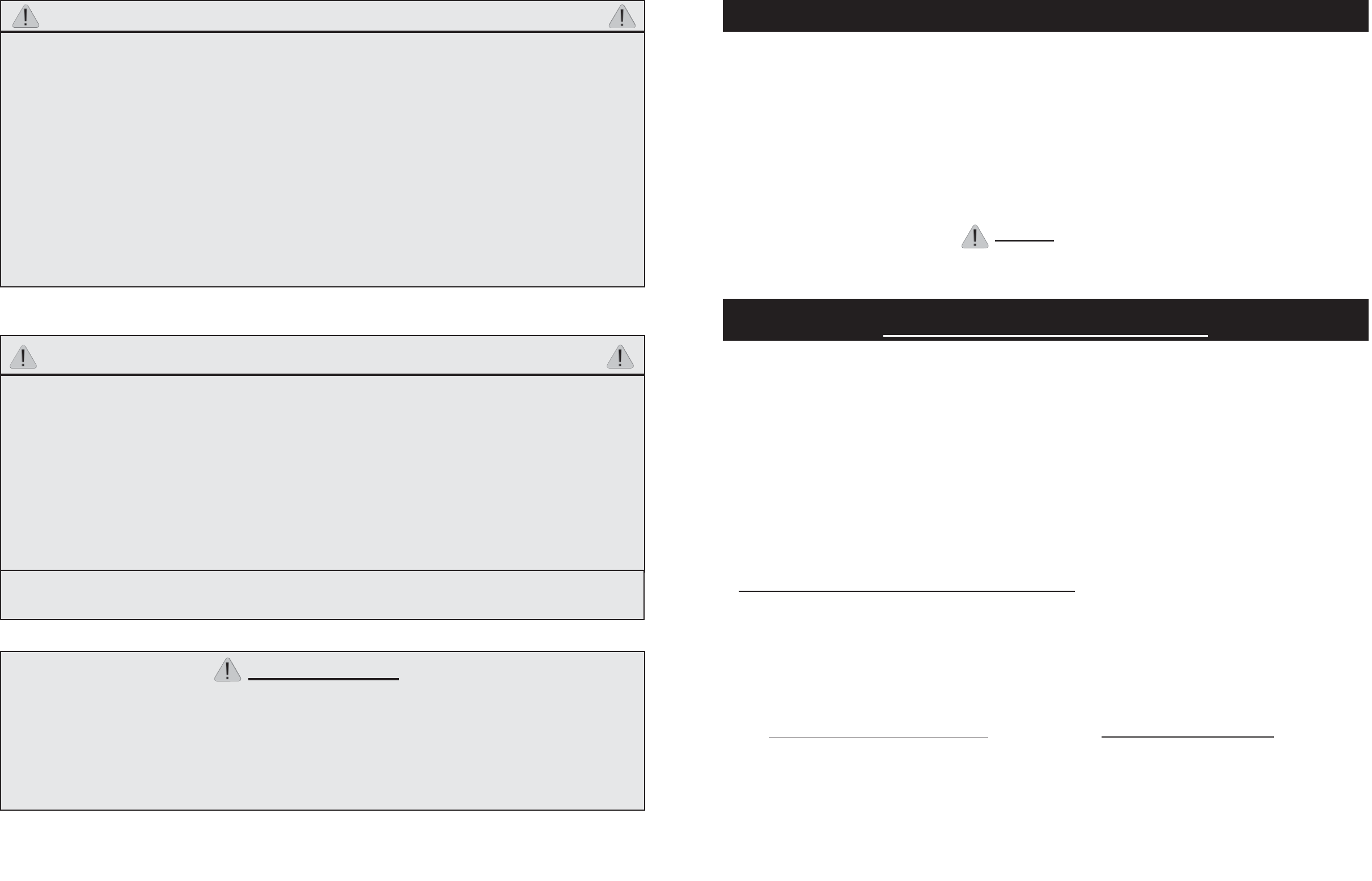
WARNING
• The use of alcohol, prescription or non prescription drugs may impair the consumer’s ability to properly
assemble or safely operate the appliance.
• Do not obstruct flow of combustion and ventilation. Keep ventilation opening(s) of the cylinder
enclosure free and clear of debris.
• The installation of this appliance must conform with local codes or, in the absence of local codes, with
the National Fuel Gas Code, ANSI Z223.1/ NFPA 54, Storage and Handling of Liquefied Petroleum
Gases, ANSI/NFPA 58, Natural Gas and Propane Installation Code, CSA B149.1, Propane Storage and
Handling, CSA B149.2, or the Standard for Recreational Vehicles, ANSI A119.2/NFPA 1192 and the
Recreational Vehicle Code, CSA Z240 RV Series.
• The LP-gas cylinder being used must be constructed and marked in accordance with the specifications
for LP-gas cylinders of the U.S. Department of Transportation (DOT) CFR 49 or the National Standards
of Canada, CAN/CSA-B339, Cylinders, Spheres and Tubes for the Transportation of Dangerous Goods.
Gas Cylinder Storage, Placement and Filling:
• Do not store a spare LP-gas cylinder under or near appliance.
• Never fill the cylinder beyond 80 percent full. Over filled cylinders can release gas.The gas cylinder
safety relief valve may overheat, allowing gas to release causing an intense fire with risk of death or
serious injury.
• If you smell, hear or see gas escaping, immediately get away from gas cylinder and call the fire
department. A fire causing death or serious injury may occur.
• Place a dust cap on cylinder valve outlet whenever the cylinder is not in use. Only install dust cap on
cylinder valve outlet that is provided with the cylinder. Other caps or plugs may cause leaks.
Gas Cylinder Storage and Appliance Check:
• Cylinders must be stored outdoors out of reach of children and must not be stored in a building,
garage, or any other enclosed area.
• Before each use check all nuts and bolts to be sure that they are tight and secure.
• Before each use inspect gas hose for any signs of damage.
• Before each use preform soapy water test.
DANGER
For Your Safety
5
18
STEP 1 - If a fill line is stamped on the pot then STEP 1 is not needed. Fill the pot with oil to the fill line
and go to STEP 2. If there is no stamped line, place thawed turkey, up to 18 lbs (8kg) MAX size, into
basket and lower turkey into empty pot. Fill pot with water until the butt of the turkey is covered. There
must be 3 in (8cm) between this water level & the top of the pot. Remove the turkey from the pot allowing
all water to drain from the turkey. Once turkey has been removed, mark the waterline. Empty the water
from the pot and fill with oil up to the marked line.
STEP 2 - Insure that turkey is completely thawed and free of excess water and ice. Inject turkey with a
marinade of your choice. Cover the outside of turkey with cajun dry rub reasoning. Replace the turkey in
basket with legs pointing up. Ignite burner (see page 9) and bring oil temperature to 350°F (177°C).
Turn the burner off before placing the turkey into oil. Wearing cooking gloves, and being sure to stay
away from hot steam, lower the turkey into the oil very slowly and cover with lid. Re-light the burner.
Using the thermometer keep the oil temperature at 350°F (177°C). Cook turkey for 3 minutes per pound
and then add 5 minutes to total cooking time. Turkey may float before cooking time is complete. Continue
cooking turkey for the total amount of time calculated. When cooking is complete, turn burner OFF and
remove food slowly.
FOR YOUR SAFETY FOLLOW THESE STEPS ON
HOW TO PROPERLY DEEP FRY A TURKEY
Thawing a Turkey in Cold Water
Thawing Times
8lb (3.6kg) to 12lb (5.4kg) 4 to 6 hours
12lb (5.4kg) to 16lb (7.3kg) 6 to 8 hours
16lb (7.3kg) to 18lb (8.2kg) 8 to 10 hours
Turkeys thawed by the cold water
method should be cooked immediately
because conditions were not
temperature controlled.
STEP 1 - Place food product (turkey) on or in the holder (basket).
STEP 2 - Place food product and holder into the empty cooking vessel.
STEP 3 - Fill the cooking vessel with water just until the food product is completely submerged. For large
pots only, there must be 3 in (8cm) between this level & the top of the vessel.
STEP 4 - Remove food product from the cooking vessel and either mark the water level on the side of the
cooking vessel or measure the amount of water in the cooking vessel.
STEP 5 - Remove water and completely dry cooking vessel and food product.
STEP 6 - This is the amount of cooking oil the cooking vessel needs to be filled with to cook your food
product.
DANGER
IF THE INFORMATION IN ITEMS 1-6 ABOVE IS NOT
FOLLOWED EXACTLY, OIL OVERFLOW MAY OCCUR RESULTING IN DEATH, SERIOUS INJURY, OR PROPERTY
DAMAGE.
Example: Cooking a 16.5 lb (7.48kg). turkey
3 minutes x 16.5 = 49.5
49.5 minutes + 5 = 54.5
Total cooking time: 54.5 minutes
STEP 3 - Turn the turkey fryer OFF and remove
the basket slowly. Hook basket to the
side of pot. This is a safe and easy way
to allow turkey to drain and cool at the
same time.
COOKING INSTRUCTIONS FOR VESSELS WITHOUT FILL LINES
Failure to follow these instructions could result in fire, explosion, or burn hazard, which could cause
property damage, personal injury or death.














